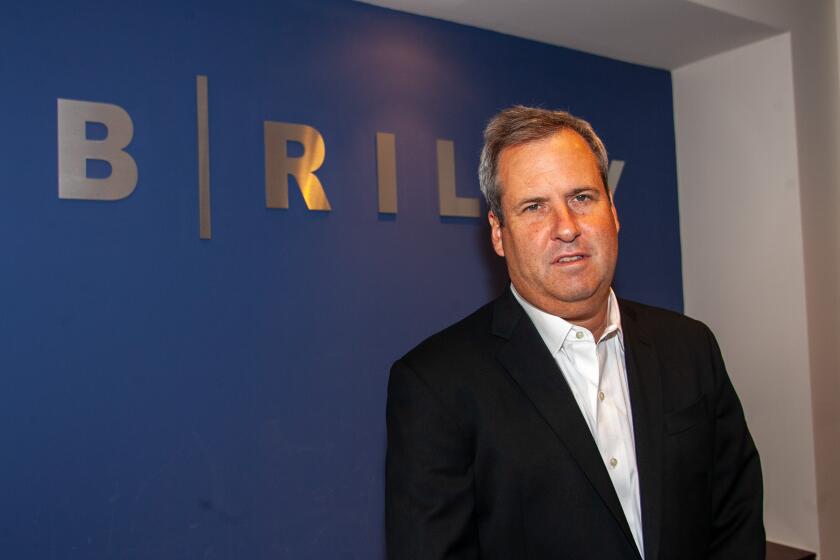Korean Air aims to travel beyond ethnic niche
SEOUL — In the early 1970s, executives of Korean Air knocked on the hotel room doors of U.S. importers who traveled here to buy wigs. They urged the Americans to use the fledgling carrier to ship the products to the States.
Three decades later, the airline has grown to become the world’s largest international air cargo carrier.
Korean Air executives are knocking on the doors of U.S. business again these days, but this time to get Americans to fly on the airline, which has attracted mostly Koreans as passengers.
“We would like more Americans to try us,” said Lee Jong Hee, president of Korean Air. “We think they’ll enjoy the experience.”
Korean Air is the busiest Asian carrier operating at Los Angeles International Airport. Its six to eight flights a day carry mostly native Koreans or passengers of Korean heritage on Boeing 747s and 777s. Southern California is home to the largest concentration of Koreans outside the country.
In an attempt to shed its image as an “ethnic” airline and attract more of the lucrative international business travel market, Korean Air is spending $9 billion over 10 years to buy new planes, add routes and spruce up aircraft cabins.
It even brought in a former designer for Christian Dior to come up with new uniforms for its flight attendants.
In December, Korean Air inked a $5.6-billion deal to buy 25 large jetliners from Boeing Co. It earlier placed an order for five 555-passenger Airbus A380s, the world’s biggest passenger jet, which the airline will begin flying in 2010.
The carrier has upgraded about 70% of its transpacific fleet with new seats. The first-class seats can be converted into beds.
Like other carriers, Korean Air is working to entice more “front of the plane” passengers who typically take up 20% of the cabin but generate 80% of the profit.
“Korean Air has made huge strides in what they are offering in business and first class,” said Christopher McGinnis, director of airline research firm Travel Skills Group and editor of an Internet newsletter for business travelers. “It’s really pulled out all the stops to make itself into a more luxurious airline.”
Hoping to recast its brand image, the airline hired a U.S. marketing firm that helped transform overnight delivery service Federal Express into simply FedEx. Korean Air adopted a new slogan, “Excellence in Flight.” And last fall it began its first U.S. advertising campaign in 10 years.
“We want to be among the top 10 airlines in the world in terms of quality and reputation,” Korean Air President Lee said in a recent interview at the company’s headquarters in Seoul. Korean Air typically has ranked in the second tier of airlines in passenger surveys, behind such top-rated Asian carriers as Singapore Airlines and Cathay Pacific Airways.
To get there, Korean Air is setting its sights on travelers flying between the U.S. and China, as low-cost carriers and fast bullet trains have intensified competition in South Korea’s domestic travel market. Revenue from domestic flights has remained relatively flat while international revenue is growing about 15% a year.
It’s simple arithmetic, Korean Air executives say: South Korea’s population is about 49 million, compared with a combined 1.6 billion in China and the U.S.
“There will be a lot of traveling between these two countries,” said Shin Hyun-oh, the airline’s general manager for China flights. “We want a big share of it.”
Other Asian airlines are targeting the U.S.-China market, but Korean Air believes that it has an advantage because of the location of its main hub in Incheon, a port city about 22 miles from Seoul that can serve as an air bridge between North America and Asia. Korean Air is one of the few Asian carriers that have extensive networks in both the U.S. and China.
Korean Air flies to 11 cities in the U.S., more than twice as many as any other Asian carrier. Incheon would link the U.S. cities with the 20 destinations Korean Air serves in China. With plans to add 12 more routes in China, Korean Air is positioning itself as a top choice for Americans flying to next year’s Summer Olympics in Beijing.
Spearheading the effort in the U.S. is the first non-Korean to lead the airline’s North American marketing and sales.
“I’m a test case,” said John E. Jackson III, director of passenger marketing and sales for the American regional headquarters in Los Angeles. Jackson, who hails from Atlanta, previously worked for several U.S. airlines, including Delta and Continental. “I do feel a little weight on my shoulder, but I think it’s important to have someone with a local perspective because business here is different” from in South Korea.
The airline appears to be making headway. Revenue is growing strongly, Jackson said, with North American flights chalking up sales growth of 20% a year and business-class seats on transpacific flights registering a 50% gain last year from 2005. For the first time it won “best business class” to Asia in a 2006 passenger survey conducted by Business Traveler magazine.
Korean Air reported last month that net income in 2006 climbed 72% to $369 million as sales rose 6.5% to $8.64 billion, fueled by growth in international travel.
The airline added 19 overseas routes last year and now flies to 109 cities in 36 countries. Its current fleet of 101 passenger jets and 27 freighters will grow by five new planes, including four long-range 777-200ERs. These are in addition to the five A380s and December’s 25-plane order with Boeing.
The expansion plans will necessitate the hiring of an additional 500 flight attendants and 230 pilots.
Korean Air began nonstop service between Seoul and Las Vegas last fall and is considering using McCarran International Airport there as a hub from which it could provide connections to other cities in the West such as Phoenix, Denver and Salt Lake City.
“We could use Las Vegas as another hub” in addition to LAX, Jackson said, adding that flights from Washington, Chicago and Tampa, Fla., also could feed into McCarran as LAX becomes increasingly crowded.
Expanding in the U.S. won’t be easy.
Singapore Airlines, considered one of the most influential in the industry, recently began flying a new Boeing 777-300ER from San Francisco to Seoul with what the airline calls the world’s most spacious first- and business-class seats.
And Korean Air archrival Asiana Airlines has begun its own makeover, with plans to buy eight new airplanes this year. The Seoul-based carrier began offering free limousine service to first- and business-class passengers last year.
For at least one American passenger taking Korean Air for the first time recently, the carrier seemed to need a bit more work to spruce up its image.
Mike Griffith, sales director for a Middleton, Wis., company, said he decided to give Korean Air a try because of the “unbelievable” fare on a trip to Australia. His round-trip business-class ticket was about $5,000 cheaper than what he would have paid flying Qantas Airways or United Airlines, the carriers he typically uses on business flights to Australia.
After a 21-hour flight from Los Angeles to Brisbane, Australia, via Seoul that cost $7,100 round trip, Griffith said, he liked the new business-class seating, which he found to be comparable in comfort to the seats on Qantas.
The Korean Air crew was “cordial and friendly and did a good job overall,” he said. All but two of the 60 seats in business class were full, with perhaps about 20% of the passengers being Korean or other Asian travelers.
Griffith said that the food was comparable to “what you might find on an average first-class domestic flight.” But “little things” bothered him, such as receiving an amenities kit consisting solely of a pair of inexpensive slippers that didn’t fit.
He said he would fly Korean Air again “if the pricing was as good.” But “if it is their intention to create a more-premium-service image, I think they have a way to go.”
More to Read
Inside the business of entertainment
The Wide Shot brings you news, analysis and insights on everything from streaming wars to production — and what it all means for the future.
You may occasionally receive promotional content from the Los Angeles Times.










